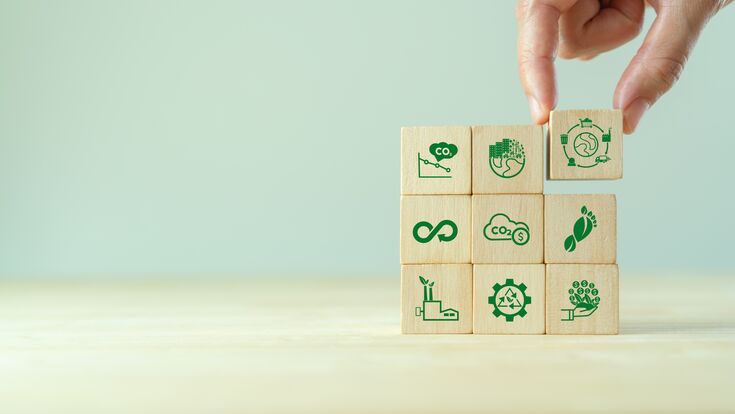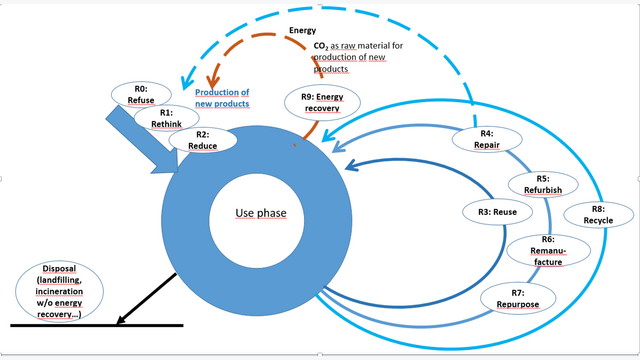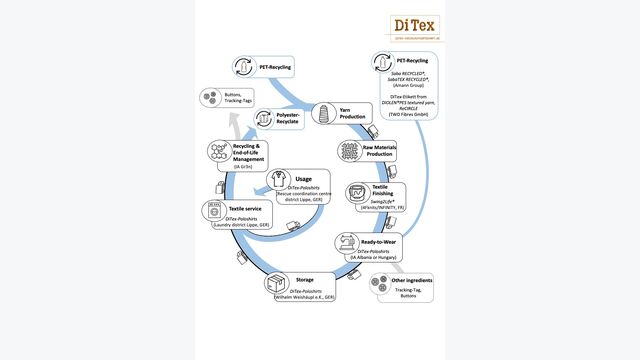Opportunities to overcome barriers in waste management : Innovative product cycles for a circular economy

“Circular economy” is a buzzword containing promises to cut waste, protect resources, and promote business. But the use of the term is inflationary. In the last decade, the number of technical papers has multiplied, and new – “circular” – business models have been created.
Two questions must be carefully considered in any circular economy investment: How can a circular economy solution be more effective than conventional waste management? How can money be earned with circular business models? Germany’s ReziProK funding measure, with 25 different R&D projects,[1] has looked for answers to both these questions. The research projects aim to close product cycles by developing design concepts, digital technologies, and appropriate business models. The research results are then to be transferred into economic practice and marketable products as quickly as possible to strengthen companies in Germany as competitive suppliers of circular economy solutions. The projects focus on:
- Promotion of the use of recycled materials
- Extension or intensification of product use
- Improving the recyclability of electric vehicles
- Optimisation and expansion of remanufacturing
- Development of information transfer along the value chain
For more details, please visit this website.
[1] “Resource-efficient Circular Economy – Innovative Product Cycles” (ReziProK) is funded by the Federal Ministry of Education and Research (BMBF). Projects started in 2019 and will be finalised by the end of 2023. The results presented here were summarised by RessWInn, a networking and transfer project within ReziProK implemented by DECHEMA, Frankfurt, Germany, and N³ Thinking Ahead, Voerde, Germany.
Obstacles for material recovery
Numerous physical, technical, and economic obstacles to material recovery and reuse are known from waste management:
The products distributed to millions of consumers in a short period become waste after being used for varying lengths of time. After use, information about their material composition and technical condition is lost. Consequently, the reuse of products from waste is mostly impossible.
In the case of recycling, we are confronted with highly entropic mixtures and unknown, potentially hazardous compounds.
These and some other stumbling stones result in many recycling processes costing too much and leaving large amounts of waste.[2]
Whereas recycling (R8) and energy recovery (R9) are well-known contributions to the circular economy that start from waste, other strategies are linked to the use phase of products, such as repair or refurbishment (R4-R7), or the design phase (R0-R2). These “circular strategies” are shown in Figure 1.
Nearly all ReziProK projects covered more than one strategy, e.g. DiTex (Fig. 2).
[2] H. Friege and K. Kümmerer: Practising Circular Economy: Stumbling Blocks for Circulation and Recycling. In “The Impossibilities of the Circular Economy – Separating Aspirations from Reality” (Eds.: Harry Lehmann, Christoph Hinske, Victoire de Margerie, and Aneta Slaveikova Nikolova). Open access
Fig. 1: “R-Strategies” aimed at reducing the consumption of material resources (modified and supplemented according to Potting and Hanemaaijer, PBL, The Hague, 2018, see PDF here
- © FriegeHow to remove obstacles
The analysis of the project results indicates that paying early attention to the above-mentioned barriers facilitates the assessment of risks and opportunities within the product life cycle. We cannot overcome physical barriers such as entropy, and we cannot predict whether a certain additive will be banned in the future. There are, however, many possibilities to remove obstacles to a circular use of resources. Here are some examples:
Many of the projects focused on design for re-use, recycling, or opportunities to repair or remanufacture a product:
- Fibre tapes made of polyethylene reinforce the durability of products made from recycled plastic and can be removed by heating to allow another recycling loop (All-Polymer, read more here).
- In the DiTex project, shirts for an ambulance crew and bed linen for hotels were made from materials that are as uniform as possible; this allows for fibre-to-fibre recycling.
- For lightweight vehicles, the number of individual parts could be reduced and repairability significantly improved by disassembling the chassis into different modules, possibilities for conversion for different uses, and easily replaceable parts in typical accident zones (KOSEL, LEVmodular). Incidentally, the lightweight vehicle built in the KOSEL project is being further developed with a municipal fleet – for the street sweepers of the future.

Information transfer
For circular business models, information along the value chain is key. The transfer of information about the material composition and application history of products requires standardised technical solutions that depend on the product in question.
- The DIBICHAIN project successfully tested the transfer of information on spare parts for aircraft via blockchain. The blockchain serves as an independent and immutable carrier for the entire supply chain, making it possible to obtain reliable information about the product. This applies for re-use, repair, and recycling, as component manufacturers can be contacted directly to request material or dismantling information.
- In the case of textiles (DiTex, see above), a dynamic RFID tag is used to provide information on the materials used, washing cycles, and repair, thus facilitating decisions between further use or recycling. Information transfer makes it possible to implement many “R strategies” within one business model, as can be seen in the process chart for a shirt (Fig. 2).
Fig. 2: Process diagram for the production, use, recycling, and tracking of shirts for an ambulance crew, Lippe District, Germany (Source: DiTex project)
- © DiTexUsing AI
If we can identify a used product from a separately collected waste fraction and are aware of its previous function, we could then decide on re-use or appropriate recycling routes. This is indeed possible:
- A self-learning system combined with different sensors and cameras assists technicians in their decision-making process (EIBA). In this project, spare parts from scrap yards were identified (producer, year of manufacture, technical condition) and assessed for further use or recycling. Watch video here.
The role of product-service systems
Product-service systems (PSS) are a suitable approach for reducing the dissipative loss of used products using well-organised reverse logistics. Three examples from ReziProK that are already on the market:
Extra challenge for B2C
Whereas B2B models are celebrating their first successes, B2C approaches are finding it much more difficult to assert themselves:
- Textile rental and clothing swaps have so far only worked for high-value goods, and it is difficult to make them economically feasible in times of “fast fashion” (Wear2Share).
- Reusable packaging for internet trade is ecologically and economically viable, but for implementation in the market, suitable processes along the value chain and a large number of participating companies are required (praxPACK, read more here).
Digitial tools
It is very difficult to assess a product’s contribution to sustainability in terms of its full “life cycle”, including reuse, recycling, etc. In the ConCirMy project, a tool (“configurator”) was developed to provide information on environmental compatibility including recycling and reuse options to various stakeholders in the supply chain, which can be taken into account in purchasing decisions. Tyres were used as an example.
Conclusion
In conclusion, the circular economy offers important opportunities to mitigate well-known problems in waste management. Further research should focus on a differentiation of economic obstacles to better clarify circular economy issues in complex value chains. Providers of waste collection systems should look for opportunities to support retro-logistics, e.g. for reusable packaging. For recyclers, the development of identification systems supported by artificial intelligence will create vast opportunities to assess used products for potential reuse and suitable recycling steps.




